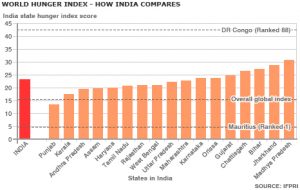India has among the highest numbers of hungry children in the world-nearly double that of sub-Saharan Africa. Even Ethiopia is placed ahead of India (94th) in the Global Hunger Index 2007 of 118 countries by the International Food Policy Research Institute. The index looks at the progress by countries on three indicators for two UN millennium goal targets for 2015: the proportion of calorie-deficient people, child malnutrition and child mortality. Most of these children belong to poor families of marginalized sections of society like Dalits and SC/STs.Most are agricultural laborers, do not own any land, have no regular livelihood and little access to food and health programmes.
According to the National Family Health Survey III 46% of our children are underweight because their mothers are also largely undernourished, 19% wasted or too thin for height and 38% have stunted growth. Around 79% of those under the age of three are anemic. All these only raise the risk of developing fatal diseases and infection. However, hunger finds no mention in the national health policy. There is a lot of focus on childhood diseases like diarrhea and polio. According to experts, the immediate need is to put hunger back on the health agenda. The ICDS is not adequately monitored and is thinly spread. An improved ICDS, the rural employment guarantee scheme and better access to the public distribution system will do a great deal in reducing hunger. There are also calls for introducing a Right to Food by many experts. The way children are forced to work in order to eat one should aspire for food security through the goal of nutrition security would be more appropriate. The mid-day meal scheme has helped but it should have been linked less with the schooling system and more with the hunger pattern.
Table of Full Results

- The problem of hunger is measured in five categories – low, moderate, serious, alarming or extremely alarming.
- The survey says that not one of the 17 states in India that were studied were in the low or moderate hunger category.
- “Despite years of robust economic growth, India scored worse than nearly 25 sub-Saharan African countries and all of South Asia, except Bangladesh,” the report says. The best-performing state was Punjab, which has a ‘serious’ hunger problem and does less well than developing countries such as Gabon, Vietnam, and Honduras.
- “When Indian states are compared to countries in the Global Hunger Index, [the central Indian state of] Madhya Pradesh ranks between Ethiopia and Chad,” it says.
- India is long known to have some of the highest rates of child malnutrition and mortality in under-fives in the world.
- According to the Indian government statistics two years ago, around 60% of more than 10 million children in the state were malnourished.
- Nutrition experts say the abysmal record is due to inadequate access to food, poor feeding practices and poor childcare practices in India.
- And now the rise in global food prices has reduced the food-buying capacity of many poor families, making their situation worse.
- In the past year, food prices have increased significantly, but people’s incomes haven’t kept pace, forcing many families further into hunger, experts say.
- The report says “improving child nutrition is of utmost urgency in most Indian states”.
- “All states also need to improve strategies to facilitate inclusive economic growth, ensure food sufficiency and reduce child mortality,” it adds.

